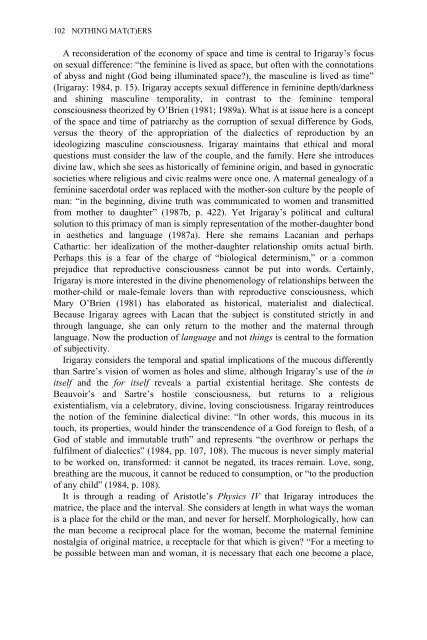Nothing Mat(t)ers: A Feminist Critique of Postmodernism
Nothing Mat(t)ers: A Feminist Critique of Postmodernism
Nothing Mat(t)ers: A Feminist Critique of Postmodernism
Create successful ePaper yourself
Turn your PDF publications into a flip-book with our unique Google optimized e-Paper software.
102 NOTHING MAT(T)ERS<br />
A reconsideration <strong>of</strong> the economy <strong>of</strong> space and time is central to Irigaray’s focus<br />
on sexual difference: “the feminine is lived as space, but <strong>of</strong>ten with the connotations<br />
<strong>of</strong> abyss and night (God being illuminated space), the masculine is lived as time”<br />
(Irigaray: 1984, p. 15). Irigaray accepts sexual difference in feminine depth/darkness<br />
and shining masculine temporality, in contrast to the feminine temporal<br />
consciousness theorized by O’Brien (1981; 1989a). What is at issue here is a concept<br />
<strong>of</strong> the space and time <strong>of</strong> patriarchy as the corruption <strong>of</strong> sexual difference by Gods,<br />
v<strong>ers</strong>us the theory <strong>of</strong> the appropriation <strong>of</strong> the dialectics <strong>of</strong> reproduction by an<br />
ideologizing masculine consciousness. Irigaray maintains that ethical and moral<br />
questions must consider the law <strong>of</strong> the couple, and the family. Here she introduces<br />
divine law, which she sees as historically <strong>of</strong> feminine origin, and based in gynocratic<br />
societies where religious and civic realms were once one. A maternal genealogy <strong>of</strong> a<br />
feminine sacerdotal order was replaced with the mother-son culture by the people <strong>of</strong><br />
man: “in the beginning, divine truth was communicated to women and transmitted<br />
from mother to daughter” (1987b, p. 422). Yet Irigaray’s political and cultural<br />
solution to this primacy <strong>of</strong> man is simply representation <strong>of</strong> the mother-daughter bond<br />
in aesthetics and language (1987a). Here she remains Lacanian and perhaps<br />
Cathartic: her idealization <strong>of</strong> the mother-daughter relationship omits actual birth.<br />
Perhaps this is a fear <strong>of</strong> the charge <strong>of</strong> “biological determinism,” or a common<br />
prejudice that reproductive consciousness cannot be put into words. Certainly,<br />
Irigaray is more interested in the divine phenomenology <strong>of</strong> relationships between the<br />
mother-child or male-female lov<strong>ers</strong> than with reproductive consciousness, which<br />
Mary O’Brien (1981) has elaborated as historical, materialist and dialectical.<br />
Because Irigaray agrees with Lacan that the subject is constituted strictly in and<br />
through language, she can only return to the mother and the maternal through<br />
language. Now the production <strong>of</strong> language and not things is central to the formation<br />
<strong>of</strong> subjectivity.<br />
Irigaray consid<strong>ers</strong> the temporal and spatial implications <strong>of</strong> the mucous differently<br />
than Sartre’s vision <strong>of</strong> women as holes and slime, although Irigaray’s use <strong>of</strong> the in<br />
itself and the for itself reveals a partial existential heritage. She contests de<br />
Beauvoir’s and Sartre’s hostile consciousness, but returns to a religious<br />
existentialism, via a celebratory, divine, loving consciousness. Irigaray reintroduces<br />
the notion <strong>of</strong> the feminine dialectical divine: “In other words, this mucous in its<br />
touch, its properties, would hinder the transcendence <strong>of</strong> a God foreign to flesh, <strong>of</strong> a<br />
God <strong>of</strong> stable and immutable truth” and represents “the overthrow or perhaps the<br />
fulfilment <strong>of</strong> dialectics” (1984, pp. 107, 108). The mucous is never simply material<br />
to be worked on, transformed: it cannot be negated, its traces remain. Love, song,<br />
breathing are the mucous, it cannot be reduced to consumption, or “to the production<br />
<strong>of</strong> any child” (1984, p. 108).<br />
It is through a reading <strong>of</strong> Aristotle’s Physics IV that Irigaray introduces the<br />
matrice, the place and the interval. She consid<strong>ers</strong> at length in what ways the woman<br />
is a place for the child or the man, and never for h<strong>ers</strong>elf. Morphologically, how can<br />
the man become a reciprocal place for the woman, become the maternal feminine<br />
nostalgia <strong>of</strong> original matrice, a receptacle for that which is given “For a meeting to<br />
be possible between man and woman, it is necessary that each one become a place,

















